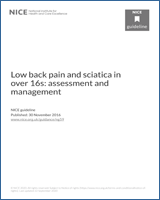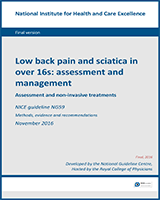NCBI Bookshelf. A service of the National Library of Medicine, National Institutes of Health.
Guideline updates: December 2020: in the recommendation on stopping opioid analgesics NICE added links to other NICE guidelines and resources that support discussion with patients about opioid prescribing and safe withdrawal management. September 2020: NICE's original guidance on low back pain and sciatica in over 16s was published in 2016. It was partially updated in September 2020. See the NICE website for the guideline recommendations and the evidence review for the 2020 update. This document preserves evidence reviews and committee discussions for areas of the guideline that were not updated in 2020.
Excerpt
This guideline covers the assessment and management of low back pain and sciatica in adults over the age of 16 years.
Low back pain causes more disability, worldwide, than any other condition. Episodes of back pain are usually transient with rapid improvements in pain and disability seen within a few weeks to a few months. Whilst the majority of back pain episodes resolve improve with initial primary care management, without the need for investigations or referral to specialist services, up to one third of patients report persistent back pain of at least moderate intensity one year after an acute episode requiring care and episodes of back pain often recur.
One of the greatest challenges remains the identification of risk factors that may predict the progression from a single back pain episode to a long term, persistent pain condition where quality of life is often very low and healthcare resource use high.
A complex and variable interplay between biological, psychological and social factors undoubtedly influences this progression and it is the modification of these factors that has become one of the mainstays of back pain research and treatment over the last decade or so.
The scope of this guideline is necessarily broad. We have reviewed the evidence for treatments and interventions individually and when used in combination - from self-management advice and simple non-invasive interventions to injections, nerve ablation techniques and spinal fusion.
We have reviewed the evidence for treatment stratification and the effectiveness of tailoring treatments to these stratified groups in the hope that clinicians know which patients are likely to need more focused and intensive treatment and which patients are likely to improve rapidly with primary care management alone, without the need for investigations or referral to specialised services.
Contents
- Guideline Development Group members
- NGC technical team members
- Co-optees
- Acknowledgements
- 1. Guideline summary
- 2. Introduction
- 3. Development of the guideline
- 4. Methods
- Assessment and Non-Invasive Treatments
- 5. Clinical examination
- 5.1. Introduction
- 5.2. Review question: In people with suspected (or under investigation for) sciatica, what is the clinical and cost effectiveness of clinical examination compared to history alone or history with imaging, when each is followed by treatment for sciatica, in improving patient outcomes?
- 5.3. Clinical evidence
- 5.4. Economic evidence
- 5.5. Evidence statements
- 5.6. Recommendations and link to evidence
- 6. Risk assessment tools and stratification
- 6.1. Introduction
- 6.2. Review question 1: Which validated risk assessment tools are the most accurate for identifying people with low back pain or sciatica at risk of poor outcome/delayed improvement?
- 6.3. Review question 2: What is the clinical and cost effectiveness of stratifying management of non-specific low back pain or sciatica according to outcome of a risk assessment tool/questionnaire?
- 6.4. Clinical evidence
- 6.5. Evidence statements
- 6.6. Recommendations and link to evidence
- 7. Imaging
- 7.1. Introduction
- 7.2. Review question: What is the clinical and cost effectiveness of performing imaging (X-ray or MRI) compared with no investigation to improve functional disability, pain or psychological distress in people with low back pain and/or sciatica?
- 7.3. Clinical evidence
- 7.4. Economic evidence
- 7.5. Evidence statements
- 7.6. Recommendations and link to evidence
- 8. Self-management
- 9. Exercise therapies
- 10. Postural therapies
- 11. Orthotics and appliances
- 12. Manual therapies
- 13. Acupuncture
- 14. Electrotherapies
- 14.1. Introduction
- 14.2. Review question: What is the clinical and cost effectiveness of electrotherapy (non-invasive interventions) in the management of non-specific low back pain and sciatica?
- 14.3. Clinical evidence
- 14.4. Economic evidence
- 14.5. Evidence statements
- 14.6. Recommendations and link to evidence
- 15. Psychological interventions
- 15.1. Introduction
- 15.2. Review question: What is the clinical and cost effectiveness of psychological therapies in the management of non-specific low back pain and sciatica?
- 15.3. Clinical evidence
- 15.4. Combinations of interventions – psychological therapy adjunct
- 15.5. Economic evidence
- 15.6. Evidence statements
- 15.7. Recommendations and link to evidence
- 16. Pharmacological interventions
- 17. Multidisciplinary biopsychosocial rehabilitation (MBR) programmes
- 18. Return to work programmes
- 19. Reference list
- 20. Acronyms and abbreviations
- 21. Glossary
- 5. Clinical examination
- Invasive Treatments
- 22. Spinal injections
- 23. Radiofrequency denervation for facet joint pain
- 24. Epidural injections for sciatica
- 25. Surgery and prognostic factors
- 25.1. Introduction
- 25.2. Review question: Does history of previous fusion surgery, smoking status, BMI or psychological distress predict response to surgery in people with non-specific low back pain?
- 25.3. Review question: Does image concordant pathology or presence of radicular symptoms predict response to surgery in people with suspected sciatica?
- 25.4. Clinical evidence
- 25.5. Economic evidence
- 25.6. Evidence statements
- 25.7. Recommendations and link to evidence
- 26. Disc replacement
- 27. Spinal fusion
- 28. Spinal decompression for sciatica
- 29 Reference list
- 30. Acronyms and abbreviations
- 31. Glossary
- Appendices A – G
- Appendix H. Clinical evidence tables
- Appendices I-J
- Appendices K-Q
Developed by the National Guideline Centre, Hosted by the Royal College of Physicians
Disclaimer: Healthcare professionals are expected to take NICE clinical guidelines fully into account when exercising their clinical judgement. However, the guidance does not override the responsibility of healthcare professionals to make decisions appropriate to the circumstances of each patient, in consultation with the patient and, where appropriate, their guardian or carer.
- Stratified versus usual care for the management of primary care patients with sciatica: the SCOPiC RCT.[Health Technol Assess. 2020]Stratified versus usual care for the management of primary care patients with sciatica: the SCOPiC RCT.Foster NE, Konstantinou K, Lewis M, Ogollah R, Saunders B, Kigozi J, Jowett S, Bartlam B, Artus M, Hill JC, et al. Health Technol Assess. 2020 Oct; 24(49):1-130.
- Microdiscectomy compared with transforaminal epidural steroid injection for persistent radicular pain caused by prolapsed intervertebral disc: the NERVES RCT.[Health Technol Assess. 2021]Microdiscectomy compared with transforaminal epidural steroid injection for persistent radicular pain caused by prolapsed intervertebral disc: the NERVES RCT.Wilby MJ, Best A, Wood E, Burnside G, Bedson E, Short H, Wheatley D, Hill-McManus D, Sharma M, Clark S, et al. Health Technol Assess. 2021 Apr; 25(24):1-86.
- Facet-joint injections for non-specific low back pain: a feasibility RCT.[Health Technol Assess. 2017]Facet-joint injections for non-specific low back pain: a feasibility RCT.Snidvongs S, Taylor RS, Ahmad A, Thomson S, Sharma M, Farr A, Fitzsimmons D, Poulton S, Mehta V, Langford R. Health Technol Assess. 2017 Dec; 21(74):1-130.
- Review WITHDRAWN: Multidisciplinary bio-psycho-social rehabilitation for chronic low-back pain.[Cochrane Database Syst Rev. 2007]Review WITHDRAWN: Multidisciplinary bio-psycho-social rehabilitation for chronic low-back pain.Guzmán J, Esmail R, Karjalainen K, Malmivaara A, Irvin E, Bombardier C. Cochrane Database Syst Rev. 2007 Jul 18; (2):CD000963. Epub 2007 Jul 18.
- Review Multidisciplinary bio-psycho-social rehabilitation for chronic low back pain.[Cochrane Database Syst Rev. 2002]Review Multidisciplinary bio-psycho-social rehabilitation for chronic low back pain.Guzmán J, Esmail R, Karjalainen K, Malmivaara A, Irvin E, Bombardier C. Cochrane Database Syst Rev. 2002; (1):CD000963.
- Low Back Pain and Sciatica in Over 16s: Assessment and ManagementLow Back Pain and Sciatica in Over 16s: Assessment and Management
Your browsing activity is empty.
Activity recording is turned off.
See more...

